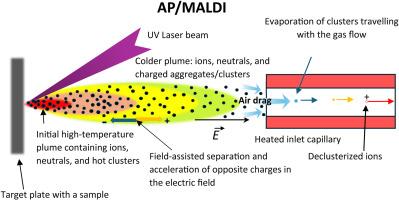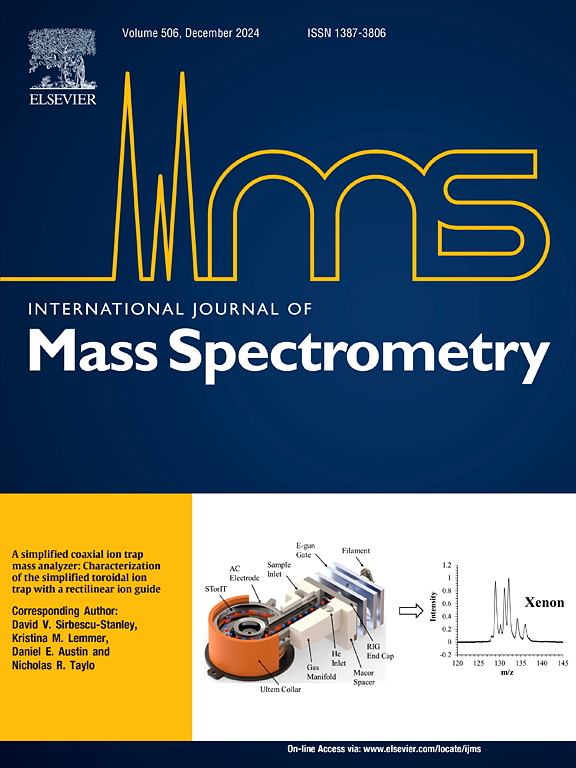Influence of acceleration field and inlet temperature on ion yields of small molecules in atmospheric pressure MALDI
IF 1.7
3区 化学
Q3 PHYSICS, ATOMIC, MOLECULAR & CHEMICAL
引用次数: 0
Abstract
The optimization of the accelerating electric field near a target plate as well as temperature of the inlet capillary in a mass spectrometer is essential for achieving a high ion yield in atmospheric pressure matrix-assisted laser desorption ionization (AP/MALDI) and atmospheric pressure/laser desorption ionization (AP/LDI). The yields of protonated rhodamine 6G ions, protonated matrix ions (M + H)+, matrix radical ions (M•)+, as well as protonated reserpine ions were studied as a function of the inlet capillary temperature in Orbitrap and electric field applied across the inlet and MALDI target plate. The findings indicated that 2,5-dihydroxybenzoic acid (DHB) generated predominantly cation radicals (M•)+ rather than protonated ions. This trend is not common for most MALDI matrices used for positive-mode MALDI-MS analysis. By changing capillary temperature, it has been found that the temperature trends observed for the (DHB + H)+/(DHB•)+ ratios in both AP/MALDI and electrospray ionization (ESI) are similar. The ion yield dependence on the electric field strength in AP/MALDI as well as low-pressure MALDI sources proved to be more complex than that suggested in the previously developed model accounting for charge neutralization in the plume mitigated by the field-driven separation of opposite charges. The laser photoionization of the matrix molecules within a thin surface layer of a matrix microcrystal followed by thermally activated proton transfer from the matrix radical cation to adjacent matrix molecules has been discussed.

常压下加速场和入口温度对小分子离子产率的影响
在常压基质辅助激光解吸电离(AP/MALDI)和常压/激光解吸电离(AP/LDI)中,优化靶板附近的加速电场和质谱仪入口毛细管温度是实现高离子产率的关键。研究了质子化罗丹明6G离子、质子化基质离子(M + H)+、基质自由基离子(M•)+和质子化利血平离子的产率与Orbitrap入口毛细管温度、入口和MALDI靶板上施加电场的关系。结果表明,2,5-二羟基苯甲酸(DHB)主要产生阳离子自由基(M•)+,而不是质子化离子。这种趋势在用于正模式MALDI- ms分析的大多数MALDI矩阵中并不常见。通过改变毛细管温度,发现AP/MALDI和电喷雾电离(ESI)中(DHB + H)+/(DHB•)+比值的温度变化趋势是相似的。在AP/MALDI以及低压MALDI源中,离子产额对电场强度的依赖性比先前开发的模型更为复杂,该模型考虑了电场驱动的相反电荷分离减轻了羽流中的电荷中和作用。本文讨论了基体微晶薄表面层中基体分子的激光光离,随后热激活质子从基体自由基阳离子转移到邻近的基体分子。
本文章由计算机程序翻译,如有差异,请以英文原文为准。
求助全文
约1分钟内获得全文
求助全文
来源期刊
CiteScore
3.60
自引率
5.60%
发文量
145
审稿时长
71 days
期刊介绍:
The journal invites papers that advance the field of mass spectrometry by exploring fundamental aspects of ion processes using both the experimental and theoretical approaches, developing new instrumentation and experimental strategies for chemical analysis using mass spectrometry, developing new computational strategies for data interpretation and integration, reporting new applications of mass spectrometry and hyphenated techniques in biology, chemistry, geology, and physics.
Papers, in which standard mass spectrometry techniques are used for analysis will not be considered.
IJMS publishes full-length articles, short communications, reviews, and feature articles including young scientist features.

 求助内容:
求助内容: 应助结果提醒方式:
应助结果提醒方式:


